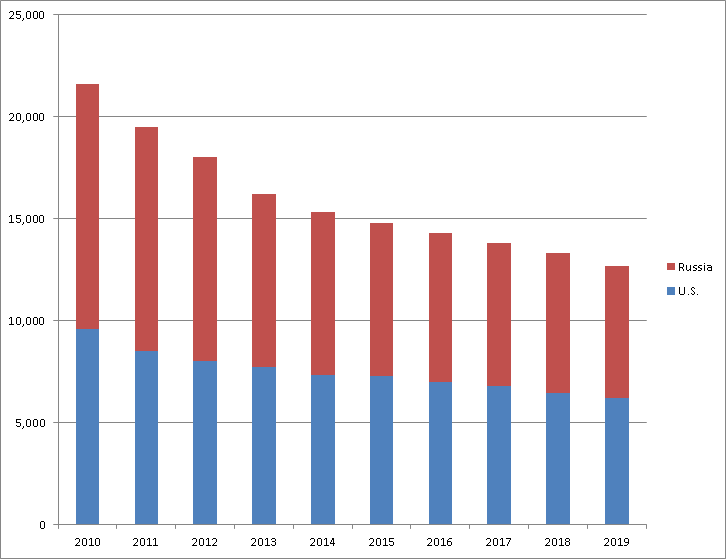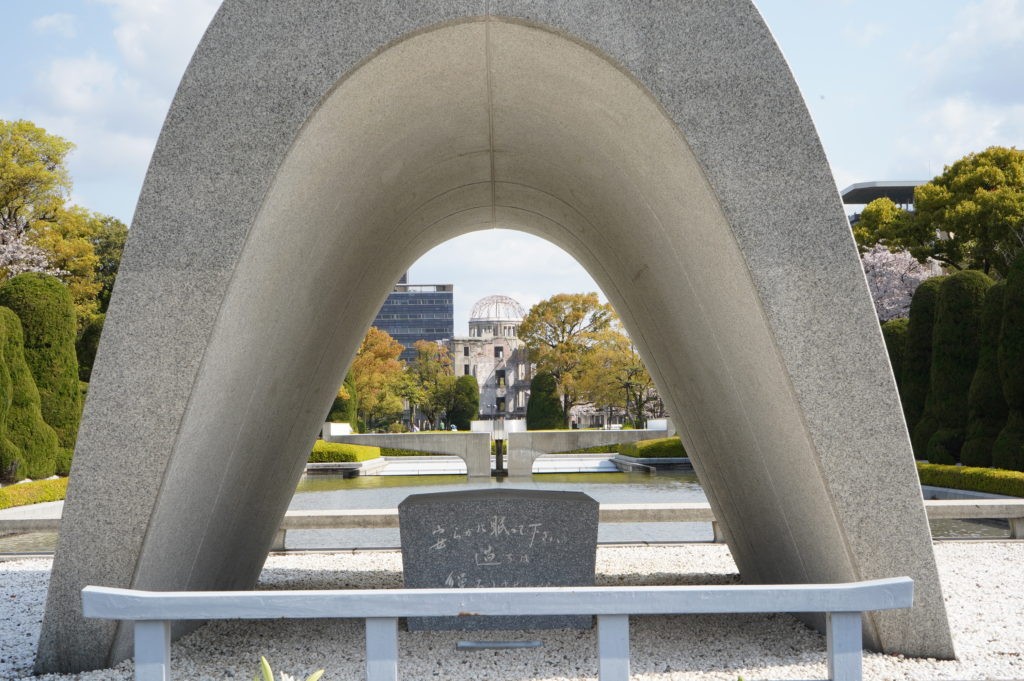Strategic Arms Reduction Talks (START)
On June 29, 1982, the United States and the Soviet Union began the Strategic Arms Reduction Talks in Geneva.
Result of this negotiation, Strategic Arms Reduction Treaty (START-I) was officially signed in 1991.
Hiroshima Report 2013 mentioned START-I as follow.
Obviously, one of the most important steps toward a world without nuclear weapons is to cut back the existing nuclear arms stockpile. Irrespective of the arguments that may be presented, without reduction elimination will never take place. To date, only Russia and the United States have agreed on and implemented the reduction of their nuclear arsenals under legally binding treaties. The two states concluded the Strategic Arms Reduction Treaty (START) I, signed in July 1991 and entered into force in December 1994, agreeing to reduce the number of deployed strategic nuclear warheads to 6,000 each. The START I was followed by the START II (signed in January 1993 but has not entered into force), which would lower the number of deployed strategic nuclear warheads to 3,000-3,500 each. Subsequently, both parties negotiated the Strategic Offensive Reductions Treaty (signed in May 2002 and entered into force in June 2003) and agreed to reduce operationally deployed strategic warheads to 1,700-2,200 for each side. Most recently, Russia and the United States concluded the New START (signed in April 2010 and entered into force in February 2011) and have undertaken obligations to reduce their stockpiles to the aggregate limits below, as counted by Article III of the Treaty, within seven years after the entry into force of the Treaty:
(a) 700, for deployed Intercontinental Ballistic Missiles (ICBMs), deployed Submarine-Launched Ballistic Missiles (SLBMs), and deployed heavy bombers;
(b) 1550, for warheads on deployed ICBMs, warheads on deployed SLBMs, and nuclear warheads counted for deployed heavy bombers; and
(c) 800, for deployed and non-deployed ICBM launchers, deployed and non-deployed SLBM launchers, and deployed and non-deployed heavy bombers.
However, while limiting the number of warheads and delivery systems, the New START, like the previous ones, does not require dismantlement of any warheads.
Hiroshima Report 2013
The number of nuclear weapons of U.S. and Russia has decreased under the legally binding treaties including START.

The New START is set to expire in February 2021, we pay attention to the future bilateral arms control agreement . According to Hiroshima Report 2020, the situation of New Start are indicated as follow.
The New START is set to expire in February 2021 in accordance with its provision. U.S. President Donald Trump has been critical of the New START, even before his inauguration in January 2017, and maintained a negative attitude toward Russia’s proposal to extend the treaty.
https://hiroshimaforpeace.com/en/hiroshimareport/report-2020/page-8/
In April 2019, the U.S. administration reportedly conducted intense interagency talks to develop options for the President to pursue a new arms control arrangement which would include China as well as Russia, and also regulate not just strategic nuclear forces but also other nuclear forces and their delivery vehicles.59 There was no indication, however, that it broached any such ideas with Russia or China.
At a Senate hearing on May 15, Under Secretary of State Andrea Thompson told that “the Administration [had] not made any decision on a potential extension of New START” She also listed issues that should be contemplated, as follows: Russia’s modernization of strategic forces; Russia’s history of violating arms control treaties; necessity of an arms control agreement for the United States and its allies; and China’s lack of transparency regarding the scope and scale of its nuclear modernization program.
On the other hand, Russia has asked the United States for an extension of the New START. In addition, while Russia argued that “any discussion of weapons not currently in New START should be part of a separate discussion about other issues,” it has expressed a significant concern about the U.S. efforts for developing strategic defense systems. At their foreign ministerial meeting in May 2019, Washington and Moscow agreed to continue talks on extending the New START. The United States has indicated that President Trump would decide in 2020 whether or not to extend the treaty.
Meanwhile, for the first time under the auspices of New START, Russia showed its new hypersonic boost glide vehicle Avangard to the U.S. inspectors on November 24-26, prior to its deployment in December. Former chief-of-staff of the Russian Strategic Missile Forces, Viktor Yesin, said, “It is a standard procedure envisaged by the [New START]. Obviously, it should give the Americans an extra stimulus to extend the treaty.” On November 27, Russian Deputy Foreign Minister Sergey Ryabkov told that Russia proposed to the United States extending the New START for five years, or for a shorter period if the United States would not want the five-year extension. Furthermore, President Vladimir Putin said in December, “Russia is ready to immediately, as soon as possible, before the end of this year, without any preconditions, extend the [New START].” However, in 2019, the two countries could not agree a future direction on the issue whether and to what extent the New START should be extended.
Since the U.S. and Russia could not agree a direction on the issue whether and to what extent the New START should be extended, we need to pay further attention to the bilateral nuclear arms control.
Timeline toward the international peaceful society free of nuclear weapons
You can learn events about nuclear disarmament and non-proliferation.
Timeline
What is today?
We introduce the date regarding nuclear disarmament and building peace.
What is today?
Tags associated with this article






